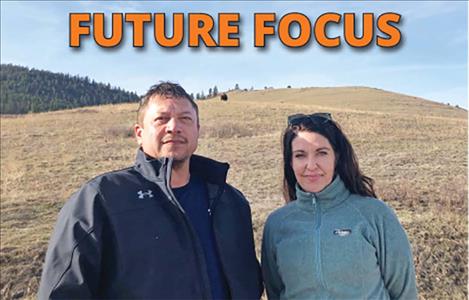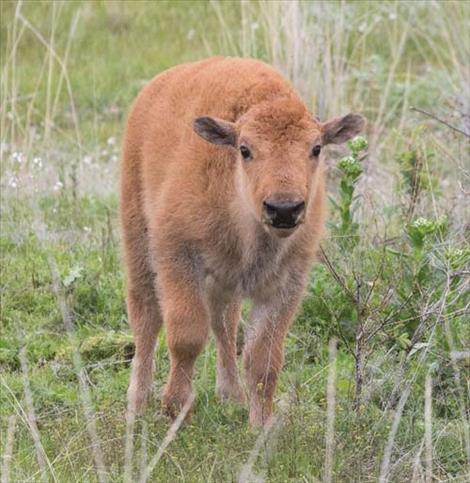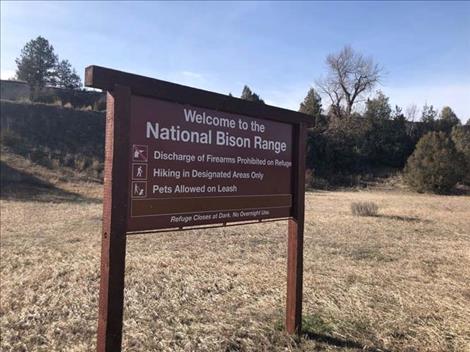Bison Range projects develop under CSKT management
Hey savvy news reader! Thanks for choosing local.
You are now reading
3 of 3 free articles.
BISON RANGE — A chorus of meadowlarks sings out along the Bison Range’s Prairie Drive on a crisp morning in early April, and the sun casts strong shadows across Red Sleep Mountain. National Bison Range Refuge Manager Amy Coffman is at the wheel and looking for two early bison calves, sighted by her crew the day before.
Coffman passes a trio of huge bulls lounging on the hillside, seemingly oblivious to her passage. A herd of elk drops into the creek bottom, a smattering of antelope scatters across the remnant of Palouse prairie, and a coyote hightails it too, his coat blending into the still tawny landscape.
The calves and their mothers have vanished from the edge of Mission Creek, but Coffman points to a large group assembled high above her. “I bet they’re up there, with the nursery,” she says.
It was a small herd of orphaned bison calves, captured and brought across the Continental Divide by tribal member Latati (Little Falcon Robe) in the 1870s, which helped save the bison from extermination. On the Flathead Reservation, the calves flourished, and were the progenitors of a large free-ranging herd owned by Michel Pablo and Charles Allard Sr.
When Congress unilaterally decided to open the Flathead Reservation to homesteading, with its attendant fencing and domestic livestock, the herd was sold. Most went to the Canadian government, which was willing to pay nearly three times as much as the U.S., and others formed the foundation of the Conrad herd in Kalispell.
When the federal government decided – again, unilaterally – to establish a bison preserve in 1908 on lands owned by the Confederated Salish and Kootenai Tribes, they paid $30,000 for 18,800 acres (about $1.60 an acre). In 1971, the U.S. Court of Claims ruled that the taking of lands from the tribes for the National Bison Range was unconstitutional.
It’s taken 113 years to rectify that particular wrong.
Beginning in the 1990s, under the leadership of Tribal Council Chairman Mickey Pablo (great-great grandson of Michel Pablo) and with the encouragement of tribal elders, the tribes launched efforts to share or take over management of the Bison Range from the U.S. Fish and Wildlife Service under the Indian Self Determination Act.
Rich Janssen, who now heads the CSKT Natural Resources Department, remembers those early efforts, spurred by the federal law that allows tribes to manage programs connected to tribal culture and history. “The Bison Range sure fit that mold,” he says.
But over the years, those attempts – often hotly contested by both a coalition of federal and state employees and other naysayers – started and stalled.
Finally, in an attachment to the giant omnibus spending bill signed Dec. 26, 2020, the Bison Range was returned to the tribes as part of the Montana Water Rights Protection Act, a historic settlement agreement between the federal government, CSKT and the state of Montana.
The land transfer “has a personal connection to all tribal members,” says Janssen. “I was very heartbroken that those who came before me are no longer with us – those who really pushed hard to see this happen.” Among them are Pablo, who died in 1999, and elders Louis Adams, Pat Pierre and Agnes Vanderburg.
“It was a total tribal effort,” he adds. “We are glad to see it finally come to fruition because it was a long time coming.”
Janssen, who is overseeing the turnover for the tribes as head of Natural Resources, points out that no revenue stream accompanies the shift in ownership. The current FWS crew is working closely with the tribes during the transition and is authorized to do so for up to two years.
A few clarifications: while the settlement agreement returns the Bison Range to the tribes, the FWS continues to manage Ninepipes and Pablo Reservoirs, and the adjacent Lake County Waterfowl Production Areas. And, despite some rumors to the contrary, the settlement does not turn over jurisdiction of the state parks around Flathead Lake to the tribes.
Tribal recreation permits will not be required to visit the Bison Range, although permits will be required (as they are presently) to fish on the stretch of Mission Creek that meanders through its boundaries. No one will be allowed to hunt on the Bison Range.
When the Red Sleep Mountain Drive opens in May (typically on Mother’s Day), visitors will be charged $10 per carload instead of the $5 that it’s been for decades. “That’s still a good deal,” says Janssen, especially compared to admission to national parks ($35 per carload), and similar to state parks ($8 for non-residents). The federal Golden Age pass for senior citizens will no longer apply to the Bison Range.
The Bison Range will always remain open to the public, which was a mandate of the transfer and a commitment by the tribes.
According to Janssen, some of the immediate plans include tackling noxious weeds – a perennial struggle on the range – and improving the 40-year-old visitor’s center to include handicap accessibility and relevant cultural content.
“We’ve got the budget ready and we’re working on position descriptions and getting those advertised to get quality applicants – tribal members who want to take part in this historic event,” says Janssen.
Department staff members are coordinating the transfer with the FWS team in what Janssen describes as an “impeccable” working relationship.
As range manager, Coffman echoes that sense of trust and collegiality. A member of the Gros Ventre Tribe and a Salish descendent, she has deep roots in the Mission Valley. She grew up in Ronan, earned a degree from Salish Kootenai College and worked at the front desk of the Bison Range Visitor Center as part of a student career program.
After graduation, she embarked on a 15-year career with FWS that’s taken her from the Bison Range, Benton Lake and the Lee Metcalf National Wildlife Refuge in Montana to Kansas, Minnesota, California and Oregon (as part of a national fire team) and to West Virginia for additional training. Most recently, she served as deputy project leader at the Rainwater Basin Wetland Management District in Nebraska.
But Montana summoned her home. She saw the Bison Range transfer on the horizon and wanted to participate in the process, so she asked to be detailed back to the range, and she returned May 20, 2019, as manager.
“I felt a really big calling to come back and help with this – whenever it happened,” she says. “I knew it was part of what I was going to do and I felt really comfortable doing it. I’m a first descendent of the Salish Tribe and deeply rooted to this area, so it’s a good fit.”
Her husband, TJ, who also grew up in Ronan, and their three kids were also on board with the return. “It was home. Grandma and grandpa were here, and we’ve been away for a decade.”
When the land transfer was finalized Dec. 26 as part of the omnibus spending bill, “it was like, ‘wow, it happened and now we’ve got to get to work,’ so that was a little bit daunting,” she says.
“It’s really one step at a time, one foot in front of the other. For me, it’s really rewarding because I get to be a part of it. This is historic.”
As she and Janssen look over the range, they discuss some of the challenges that they are navigating one step at a time. Among the intricacies are visitors’ services, fee collection, research, weed control, road maintenance, signage and, of course, caring for the 300 bison and other critters that roam the range, as well as ensuring that those animals have adequate forage. Also complicated is managing the flood of visitors – up to 250,000 a year – that streams through the range, especially during the summer months.
The Bison Range Complex has a small staff that includes Coffman, three maintenance workers, a biologist, a visitors’ service manager, and a budget technician, who runs a larger budget program within the region. The lone law enforcement officer no longer covers the Bison Range since those were among the first duties that shifted to the tribes.
With a small staff, “we wear a lot of different hats,” says Coffman. The tribes, on the other hand, have many more employees and more specialized programs. “Their resources are awesome.”
Janssen also notes that the tribes are more “adaptable and quicker” than the federal government when it comes to adjusting rules and regulations to meet current needs.
“You meet with leadership twice a week and can get immediate approval most of the time. It just doesn’t take long,” he says. “The thing the tribes are really in charge of is their lands, and this (he gestures broadly to the landscape) becomes part of that.”
Both are keenly aware of the challenges of controlling noxious weeds. Coffman says the range biologist, Amy Lisk, has taken innovative approaches to weed control. “She’s an expert in that field and has a lot of knowledge and expertise to pass on.”
Coffman herself has “probably spent three-quarters of my career spraying weeds or trying to figure out how to get on top of it. Sometimes you have to work with them, sometimes you have to work against them.” Either way, it’s a time-consuming and costly part of range management.
Day-by-day, hurdle-by-hurdle, “we’re working together,” says Janssen. “We both have the same mission, which is to protect and enhance and manage in perpetuity the resources that are out there right now.”
“The Fish and Wildlife Service has done a wonderful job of conserving the bison population and managing the refuge, but stepping away gracefully is now our job in the whole scheme of things, and supporting the tribes so they have every tool to get going is our job as well,” says Coffman.
“This is the tribes forever now, and I just can’t wait to see what they do with it.”
“It’s not going away,” vows Janssen. “We’re going to have it forever and we want to pass it on to our children and grandchildren in better condition than we found it.”


















